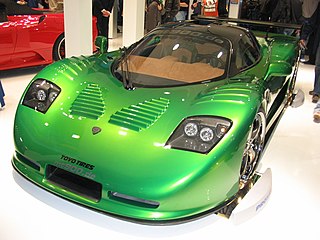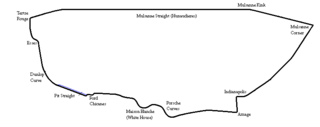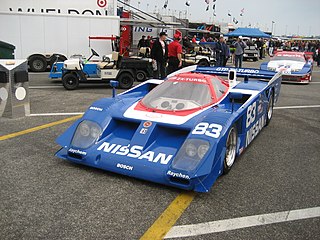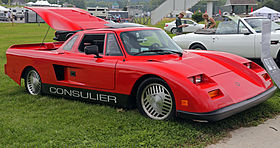
The Porsche 935 is a race car that was developed and manufactured by German automaker Porsche. Introduced in 1976 as the factory racing version of the 911 (930) Turbo and prepared for FIA-Group 5 rules, it was an evolution of the Carrera RSR 2.1 turbo prototype, the second place overall finisher in the 1974 24 Hours of Le Mans.

Mosler Automotive was an American sports car manufacturer headquartered in Riviera Beach, Florida. It was founded in 1985 by Warren Mosler as Consulier Industries, and manufactured the Consulier GTP, which was later rebranded and updated as the Mosler Intruder/Raptor when the company spun off its automotive division as Mosler Automotive.

The Mosler MT900 is a high performance sports car built by now-defunct American automotive manufacturer Mosler Automotive.

The Porsche 962 is a sports prototype racing car designed and built by Porsche. Created to replace the Porsche 956, 962 was introduced at the end of 1984 and replaced the 956 in the IMSA's GTP class in 1985 due to regulation changes obsoleting the 956. It was also introduced in the World Sportscar Championship's Group C category in 1984. Over its decade-long career, the car in its Group C form won the 24 Hours of Le Mans twice, with a derivative of the car, the Dauer 962 Le Mans, winning a further title in 1994. In total, the 962 scored nineteen total constructor's championships across various series. The 962's successor was the Porsche WSC-95, introduced for the 1996 24 Hours of Le Mans, but did not receive factory backing or support.

A Daytona Prototype was a type of sports prototype racing car developed specifically for the Grand American Road Racing Association's Rolex Sports Car Series as their top class of car, which replaced their main prototype racing class, specifically Le Mans Prototypes (LMPs). The cars later competed in the merged series of the IMSA SportsCar Championship, from 2014 to 2016, before being phased out and replaced by the Daytona Prototype International class in 2017. They are named after the main series event, the Rolex 24 at Daytona.

The Chevrolet Corvette (C4) is the fourth generation of the Corvette sports car, produced by American automobile manufacturer Chevrolet from 1983 until 1996. The convertible returned, as did higher performance engines, exemplified by the 375 hp (280 kW) LT5 found in the ZR-1. In early March 1990, the ZR-1 would set a new record for the highest 24 hour-5,000 mile land-speed by going over a speed of 175 mph (282 km/h). With a completely new chassis, modern sleeker styling, and other improvements to the model, prices rose and sales declined. The last C4 was produced on June 20, 1996.

The 1990 24 Hours of Le Mans was the 58th Grand Prix of Endurance, taking place at the Circuit de la Sarthe, France, on the 16 and 17 June 1990. Once again, the ongoing dispute between the ACO and the FISA governing body meant the race was not part of the World Sports-Prototype Championship. This was the last Le Mans run under the Group C formula, and a number of manufacturers put in a major effort to win, with the notable exception of defending winners Sauber-Mercedes.

The 1984 24 Hours of Le Mans was the 52nd Grand Prix of Endurance, and took place on 16 – 17 June 1984. It was also the third round of the 1984 World Endurance Championship. There were two big stories going into the race weekend: the absence of the Porsche works team and their drivers, and the return of Jaguar. Bob Tullius had commissioned the new Jaguar XJR-5 to run in the IMSA series and entered two for Le Mans. Earlier in the year, FISA had announced abrupt changes to the fuel regulations to bring them more in line with IMSA. Porsche and Lancia objected strongly because of their strong investment in the existing rules. In the absence of dominant Porsche works team, the race was left wide open between Lancia and the number of strong Porsche customer teams.

The 1978 24 Hours of Le Mans was the 46th Grand Prix of Endurance, and took place on 10 and 11 June 1978. In many ways it was a continuation of the race from the year before – the two main protagonists would be the very evenly-matched works teams of Alpine-Renault and Porsche, with four cars each. The race was not valid for any championship.

The 1977 24 Hours of Le Mans was the 45th Grand Prix of Endurance, and took place on 11 and 12 June 1977. The second year of the FIA Group 5 and Group 6 regulations, it produced an exciting race right up to the end. Porsche had withdrawn from the Group 6 Championship, citing a lack of broad competition. Renault, before their move into Formula 1, decided to put its main racing focus for the year onto Le Mans. The two works teams were the pre-race favourites.

Lingenfelter Performance Engineering (LPE) is an American automotive engineering company specializing in high-performance automobile modifications, specifically engines and induction systems. Now headquartered in Brighton, Michigan the company was founded by and named for NHRA driver John Lingenfelter in Decatur, IN. Over the decades since its founding, LPE has been creating high-performance versions of many GM vehicles, such as the F-Bodies, B Bodies, Corvette, CTS-V, GTO, Silverado, Suburban, Tahoe, Escalade, Denali, SSR, Hummer H2, and Sierra. Furthermore, it has also created performance enhancement packages for the Dodge Viper and Plymouth Prowler.

The 1976 24 Hours of Le Mans was the 44th Grand Prix of Endurance, and took place on 12 and 13 June 1976. This year the FIA introduced its new Group 5 and Group 6 regulations and the race was now open to nine distinct classes, although it was still not part of the World Championship seasons. Porsche introduced its new models, the 936 in Group 6, the 935 in Group 5 and the 934 in Group 4. In response, BMW had its modified 3.0 CSL in Group 5. It was the year that turbos arrived in considerable numbers, with over a dozen turbocharged entries, led by the Renault Alpine A442. It saw the arrival of French prototype manufacturers Jean Rondeau and Gérard Welter in a new GTP class and a first-time invitation to American IMSA and NASCAR entries.

The Porsche 911 GT2 is a high-performance, track-focused sports car built by the German automobile manufacturer Porsche from 1993 to 2009, and then since 2010 as the GT2 RS. It is based on the 911 Turbo, and uses a similar twin-turbocharged engine, but features numerous upgrades, including engine enhancements, larger brakes, and stiffer suspension calibration. The GT2 is significantly lighter than the Turbo due to its use of rear-wheel-drive instead of all-wheel-drive system and the reduction or removal of interior components. As a result, the GT2 is the most expensive and fastest model among the 911 lineup.
Callaway Cars Inc. is an American specialty vehicle manufacturer and engineering company that designs, develops, and manufactures high-performance product packages for cars, pickup trucks, and SUVs. They specialize in Corvettes and GM vehicles. New GM vehicles are delivered to Callaway facilities where these special packages and components are installed. Then the vehicles are delivered to GM new car dealers where they are sold to retail customers, branded as Callaway. Callaway Cars is one of four core Callaway companies, including Callaway Engineering, Callaway Carbon and Callaway Competition.

IMSA GT was a sports car racing series organized by International Motor Sports Association. Races took place primarily in the United States and occasionally in Canada.

The Chevrolet Corvette GTP was an American Grand Touring Prototype-class sports prototype racing car which successfully participated in the IMSA Camel GT from 1984 until 1989. The car was professionally fielded in competition as General Motors' Chevrolet Corvette C4 official factory team effort in the IMSA GTP class.

The Nissan GTP ZX-Turbo was a series of racing cars developed for Nissan Motors by Electramotive Engineering to compete in the IMSA GT Championship. Running from 1985 to 1990, they were known for being the first car to defeat the Porsche 962 which had dominated IMSA's premiere GTP category. This led to Nissan winning the constructor's championship and 12 Hours of Sebring in 1989 and 1990. During 1990, the GTP ZX-Turbo was replaced by the newer NPT-90.

The Lola T600 was a racing car introduced in 1981 by Lola Cars as a customer chassis. It was the first GT prototype race car to incorporate ground-effect tunnels for downforce. The revolutionary aerodynamic design of the T600 was widely imitated throughout the 1980s by International Motor Sports Association (IMSA) and Group C prototype cars. The Lola T600 ran initially in the U.S.-based IMSA GT series and later in European Group C races.
The Ford Mustang GTP was an American race car constructed to compete in the IMSA GTP series by Ford in 1983, based on the "Fox-Body" generation of the Ford Mustang road car. In 1983 the engine was a 1.7 liter twin turbo supplied by Zakspeed. In 1984 it used a destroked 2.1-litre 16 valve turbocharged variant of the 2.3 litre Ford Lima engine, capable of producing around 600 hp. The 2.1 litre engine is often misidentified as more common 2.1 litre variant of the BDA. Contrary to convention for an IMSA GTP car, the engine was fitted in the front of the car. Zakspeed would replace the car with the Ford Mustang Probe for 1985, while Roush Performance would build the no more successful V8-powered Ford Mustang Maxum GTP in 1987.

The Porsche 963 is an LMDh sports prototype racing car designed by Porsche and built by Multimatic, to compete in the Hypercar and GTP classes in the FIA World Endurance Championship and IMSA SportsCar Championship, respectively. The 963 name draws inspiration from the Porsche 956 and Porsche 962 that raced in the 1980s, which also competed in American and European racing series. The car was revealed at the 2022 Goodwood Festival of Speed, with a traditional red, white, and black livery.





















